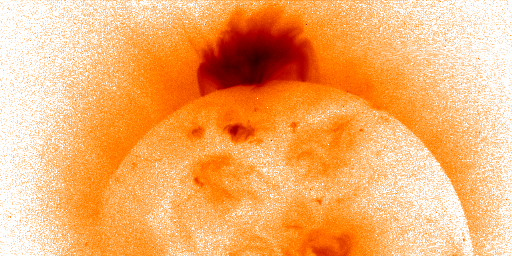
Don Melrose has added a new model and stirred the already turbulent pot of solar flare theories.
Solar flares are spectacular explosions in the Sun's corona which produce emission from radio waves to gamma rays. Large solar flares can also produce energetic particles that affect radio communications on the Earth and can be a serious hazard for astronauts. Understanding how flares occur helps in predicting when they might occur, with obvious benefits.

An X-ray image of a post-flare region on the Sun (top) from the Yohkoh mission of ISAS, Japan. The intensity of the X-rays from the hot material is indicated by the colour, from low intensity (white) to high intensity (red to black). The hot material traces the magnetic field, showing loops in several places. The Yohkoh X-ray telescope was prepared by the Lockheed Palo Alto Research Laboratory, the National Astronomical Observatory of Japan, and the University of Tokyo with the support of NASA and ISAS.
Significant controversy surrounds two opposing viewpoints on the underlying mechanism of solar flares. One viewpoint is based on an analogy with an electric current in a wire: when the current is too large the wire overheats explosively -- a phenomenon exploited in the common electric fuse used to protect electrical circuits. The other viewpoint is based on stresses in magnetic fields. Solar flares are associated with ``active regions'' comprising several sunspots and magnetic field loops which rise out of the Sun at one sunspot and return at another. An active region comprises several sunspot pairs which move relative to each other due to turbulent motions. This twists up the magnetic fields, like elastic bands, until the stresses are too large and are released explosively, like an elastic band snapping and unwinding rapidly.
Don Melrose has argued that there are deficiencies with both classes of models and has developed a third model. Don points out that the electric current models have been based on a supposed analogy with an electric circuit in wires, which leads to some erroneous conclusions. On the other hand, the class of magnetic models ignores the fact that enormous currents are observed to flow from one footpoint to the other. He has developed a model based on the electric current viewpoint, but avoiding the known errors associated with it. The model includes two pairs of footpoints and their associated loops of currents and magnetic flux. The magnetic fields ``reconnect'', or rearrange themselves, so that there are two new loops of magnetic field connecting different footpoints (as in the old models), but now the electric currents also rearrange themselves in the same way the magnetic fields do. The change in the current system releases energy and this appears sufficient to be the energy source for the flare.